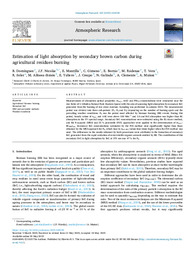Please use this identifier to cite or link to this item:
https://hdl.handle.net/11000/36926Full metadata record
| DC Field | Value | Language |
|---|---|---|
| dc.contributor.author | Dominguez, B. | - |
| dc.contributor.author | Nicolás, J.F. | - |
| dc.contributor.author | Mantilla, E. | - |
| dc.contributor.author | Gimeno, C. | - |
| dc.contributor.author | Borrás, E. | - |
| dc.contributor.author | Ródenas, M. | - |
| dc.contributor.author | Vera, T. | - |
| dc.contributor.author | Soler, R. | - |
| dc.contributor.author | Alfonsea-Simón, M. | - |
| dc.contributor.author | Yubero, E. | - |
| dc.contributor.author | Crespo, J. | - |
| dc.contributor.author | Galindo, N. | - |
| dc.contributor.author | Clemente, A. | - |
| dc.contributor.author | Muñoz, A. | - |
| dc.contributor.other | Departamentos de la UMH::Física Aplicada | es_ES |
| dc.date.accessioned | 2025-07-24T08:05:07Z | - |
| dc.date.available | 2025-07-24T08:05:07Z | - |
| dc.date.created | 2025 | - |
| dc.identifier.citation | Atmospheric Research Volume 325, 15 October 2025 | es_ES |
| dc.identifier.issn | 0169-8095 | - |
| dc.identifier.uri | https://hdl.handle.net/11000/36926 | - |
| dc.description.abstract | Measurements of absorption optical properties (σap,λ, AAE) and PM10 concentrations were conducted near the rice fields of L'Albufera Natural Park (Eastern Spain) with the aim of assessing light absorption by secondary BrC generated from the burning of rice straw residues. Sampling was performed in autumn 2023. The measurement period was divided into three sub-periods (P1, P2 and P3) depending on the number of burning spots and the prevailing weather conditions. P2 was the period most affected by biomass burning (BB) events. During this period, hourly values of σap,λ and AAE were above 100 Mm−1 and 2.0 and BrC absorption was higher than BC absorption in the UV spectral range. Secondary BrC concentrations were estimated using the EC-tracer method, and the R-squared (MRS) and 25 % percentile (P25) approaches were applied to the determination of (σap,λ/BC880)pri. Secondary BrC concentrations calculated by the P25 method were significantly higher than those obtained by the MRS approach for P2, which lead to σBrC-SEC values four times higher when the P25 method was used. The differences in the results obtained by both procedures were attributed to the formation of secondary BrC generated from the rapid oxidation of semi-volatile organic aerosols emitted by BB. The contribution of this secondary BrC to light absorption by BrC at 370 nm was 47 % for P2. | es_ES |
| dc.format | application/pdf | es_ES |
| dc.format.extent | 9 | es_ES |
| dc.language.iso | eng | es_ES |
| dc.publisher | Elsevier | es_ES |
| dc.rights | info:eu-repo/semantics/openAccess | es_ES |
| dc.rights.uri | http://creativecommons.org/licenses/by-nc-nd/4.0/ | * |
| dc.subject | Agricultural biomass burning | es_ES |
| dc.subject | Secondary BrC | es_ES |
| dc.subject | MRS and percentile methods | es_ES |
| dc.subject | Weather conditions | es_ES |
| dc.subject.other | CDU::5 - Ciencias puras y naturales::53 - Física | es_ES |
| dc.title | Estimation of light absorption by secondary brown carbon during agricultural residues burning | es_ES |
| dc.type | info:eu-repo/semantics/article | es_ES |
| dc.relation.publisherversion | https://doi.org/10.1016/j.atmosres.2025.108239 | es_ES |

View/Open:
Atmos. Res..pdf
2,28 MB
Adobe PDF
Share:
.png)
